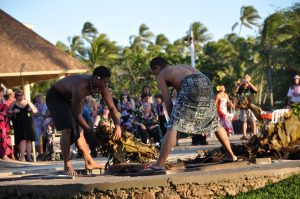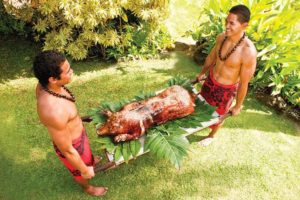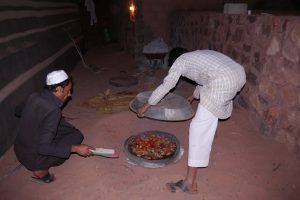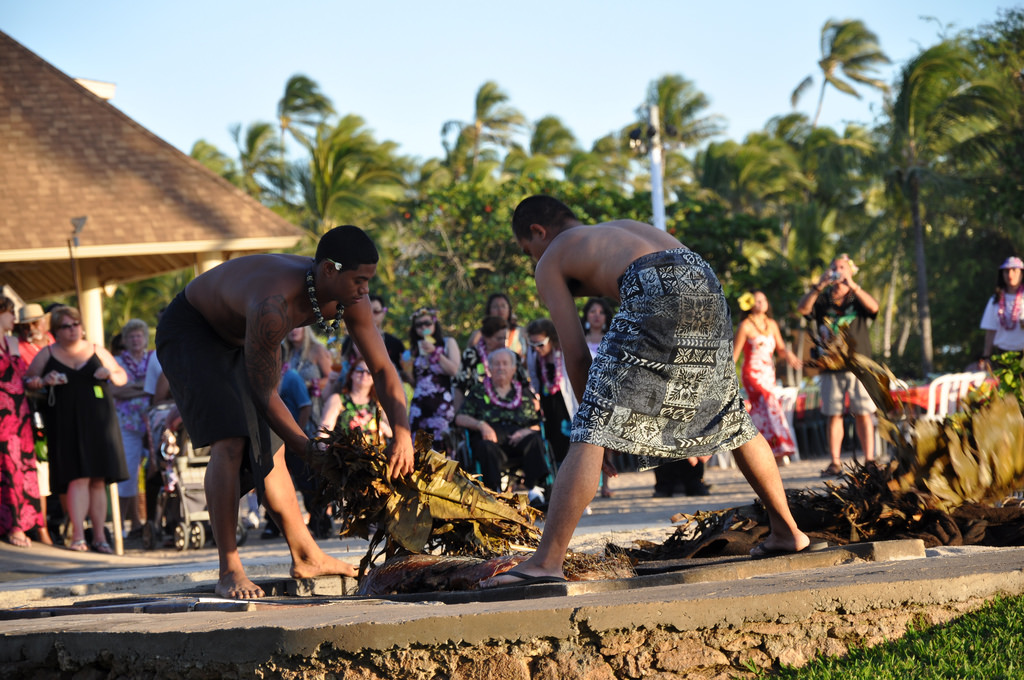What is an Imu?
by Mark L., January 15, 2019

When you attend a Hawaiian luau, you’ll find yourself immersed in customs passed down from generation to generation.
Luau traditions, which originated from various parts of Polynesia, influence every aspect of the festivities. This is especially true when it comes to food preparation.
The imu, an inground oven, is the traditional method of cooking used at a Hawaiian Luau. Kalua pig and other delicacies for the luau feast slow-roast in the imu.
Imus can slow-cook large quantities of food at one time. While it may seem like an easy method of cooking, the work lies in the preparation. Simply put, it starts with digging a massive hole into the ground. There’s a reason why the imu is almost exclusively used for special occasions!
Building an Imu

By the time you arrive at a luau, the imu has already been dug and the food buried within has been cooking for hours. In preparation, a roughly 2-to 4-foot deep hole, with sloping sides, is dug. Although the overall amount of food determines the size of the imu.
Kindling is used to start the fire and rocks are traditionally used as a base for the food to sit on. Between the rocks and the meat is a bed of banana leaves, ti leaves, and coconut palm leaves and a bed of vegetables that simmer in the juices of the protein, which at most luaus is a whole pig that will be shredded to make kalua pork. Another popular dish cooked in the imu is laulau, which is fish and vegetables tightly wrapped in taro leaves and steamed along with the pig.
The cooking process uses steam, which helps keep everything moist, and in the case of the pork, incredibly tender. The whole process: building the imu, heating the stones, and cooking the food, takes the better part of a day. The end product, however, is well worth the wait. The mingling of flavors and the tender, juicy meat are exquisite.
Earth Ovens Beyond the Hawaiian Islands
While earth ovens are a well-known part of Hawaiian luaus, they are not exclusive to the islands. In fact, historical evidence suggests that earth ovens have been in use for thousands of years, worldwide.
North America

Researchers have found signs of early earth ovens in Central Texas. Meanwhile, New England residents still use the cooking method today at clam bakes. This method is a Native American tradition that involves heated rocks, a layer of seaweed, and the main course. And of course, traditional Mexican Barbacoa is cooked in a hole in the ground and covered by agave leaves.
Europe
While baking in underground ovens is not currently common practice in Europe, they were regularly used during the Neolithic and the Bronze and Iron Ages. Likewise, the Greeks used a similar cooking method known as “thief style” (kleftiko). This method involved using clay to wrap the food and cook it in a covered pit.
North Africa & the Middle East

Similar to the Hawaiian imu, cooks in North Africa restrict the use of the earth oven to special occasions. In Morocco, the meat of choice is lamb and the oven is a tandir.
Using an earth oven is also a common cooking method among Bedouin nomads, who travel without the luxuries of kitchen equipment. They often use earth ovens to bake bread. The bread dough is often placed directly on the hot sands beneath a campfire and covered with hot coals while it bakes.
Around the Pacific

Residents of islands throughout the Pacific use earth ovens for special occasions. Other parts of Polynesia frequently call the oven an umu. Meanwhile, in Micronesia, they call it a lovo or koua. In the Solomon Islands, they call their underground ovens toku.
Modern Hawaiian Luaus
Today, some commercial Hawaiian luaus include an imu demonstration. (Unfortunately, the food cooked in the oven often cannot be served to guests due to Health Code regulations).
If you’d like to see an imu up-close while in Hawaii, the three luaus below have the most in-depth demonstrations.






